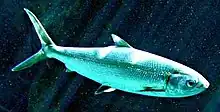| Gonorynchiformes Temporal range: Early Cretaceous - Recent | |
|---|---|
 | |
| Milkfish, Chanos chanos | |
| Scientific classification | |
| Domain: | Eukaryota |
| Kingdom: | Animalia |
| Phylum: | Chordata |
| Class: | Actinopterygii |
| Superorder: | Ostariophysi |
| Order: | Gonorynchiformes L. S. Berg, 1940 |
| Type species | |
| Gonorynchus gonorynchus (Linnaeus, 1766) | |
| Families | |
|
Chanidae (milkfish) | |
The Gonorynchiformes /ɡɒnəˈrɪŋkɪfɔːrmiːz/ are an order of ray-finned fish that includes the important food source, the milkfish (Chanos chanos, family Chanidae), and a number of lesser-known types, both marine and freshwater.
The alternate spelling "Gonorhynchiformes", with an "h", is frequently seen but not official.
Gonorynchiformes have small mouths and no teeth. They are the sole group in the clade Anotophysi, a subgroup of the superorder Ostariophysi. They are characterized by a primitive Weberian apparatus formed by the first three vertebrae and one or more cephalic ribs within the head. This apparatus is believed to be a hearing organ, and is found in a more advanced and complex form in the related cypriniform fish, such as carp.[1] Also like the cypriniforms, the gonorynchiforms produce a substance from their skin when injured that dissolves into the water and acts an alarm signal to other fish.[2]
Taxonomy
Although many of the families are rather small, there are several fossil genera. This listing of the groups of Gonorynchiformes includes fossil fish with a short description.[1] They are listed in approximate order of how primitive their characteristics are.
| Phylogeny of living Gonorynchiformes[3] | |||||||||||||||||||||||||||||||||||||||
|
- Order †Sorbininardiformes Taverne 1999
- Family †Sorbininardidae Taverne 1999
- Genus †Sorbininardus Taverne 1999
- Family †Sorbininardidae Taverne 1999
- Order Gonorynchiformes Regan 1909[4]
- Suborder Gonorynchoidei - beaked sandfishes
- Family †Apulichthyidae Taverne 1997
- Genus †Apulichthys Taverne 1997
- Family Gonorynchidae Fowler 1941
- †Anormurus de Blainville 1818
- †Chanopsis Casier 1961
- †Charitopsis Gayet 1993 non Trjapitzin 1969
- †Gonorynchidarum otolith
- †Hakeliosomus Gayet 1993
- †Protocatostomus Whitfield 1891
- †Ramallichthys Gayet 1982
- Subfamily †Charitosominae
- †Charitosomus Hosius & Von Der Marck 1885 - Cretaceous
- Subfamily †Judeichthyinae
- †Judeichthys Gayet 1985
- Subfamily Gonorynchinae
- †Notogoneus Cope 1885 - from North America, Europe, Australia; some freshwater; Late Cretaceous to Oligocene
- Gonorynchus Gronow 1763 ex Scopoli 1777
- Family †Apulichthyidae Taverne 1997
- Suborder Chanoidei Berg 1937
- †Aethalinopsis Gaudant 1967 - Early Cretaceous
- Family Chanidae Günther 1868 (milkfishes)
- †Cabindachanos Taverne et al. 2019 - Paleocene[5]
- Subfamily †Rubiesichthyinae Poyata-Ariza 1996
- Genus †Gordichthys Poyata-Ariza 1994- Early Cretaceous Chanid
- Genus †Nanaichthys Amaral & Brito 2012
- Genus †Rubiesichthys Wenz 1984 - Early Cretaceous Chanid
- Subfamily Chaninae
- Genus Chanos Lacépède 1803
- Genus †Dastilbe Jordan 1910 - Early Cretaceous Chanid
- Genus †Francischanos Ribeiro et al. 2022 - Early Cretaceous Chanid[6]
- Genus †Parachanos Arambourg & Schneegans 1935 - Early Cretaceous Chanid
- Genus †Tharrhias Jordan & Branner 1908 - Early Cretaceous Chanid
- Genus †Vango Murray et al. 2023 - Late Cretaceous Chanid[7]
- Suborder Knerioidei
- Family Kneriidae Günther 1868
- Genus †Mahengichthys Davis, Arratia & Kaiser 2013
- Subfamily Kneriinae (Shellears)
- Tribe Cromeriini
- Genus Cromeria Boulenger 1901
- Genus Grasseichthys Géry 1964
- Tribe Kneriini
- Genus Kneria Steindachner 1866
- Genus Parakneria Poll 1965
- Tribe Cromeriini
- Family Phractolaemidae
- Genus Phractolaemus Boulenger 1901 (Hingemouths/snake mudheads)
- Family Kneriidae Günther 1868
- Suborder Gonorynchoidei - beaked sandfishes
Timeline of genera

References
- 1 2 Nelson, Joseph, S. (2006). Fishes of the World. John Wiley & Sons, Inc. ISBN 0-471-25031-7.
{{cite book}}: CS1 maint: multiple names: authors list (link) - ↑ Banister, Keith F. (1998). Paxton, J.R.; Eschmeyer, W.N. (eds.). Encyclopedia of Fishes. San Diego: Academic Press. pp. 96–97. ISBN 0-12-547665-5.
- ↑ Thomas J. Near, Alex Dornburga, Matt Friedman (2014): Phylogenetic relationships and timing of diversification in gonorynchiform fishes inferred using nuclear gene DNA sequences (Teleostei: Ostariophysi). Molecular Phylogenetics and Evolution, DOI:10.1016/j.ympev.2014.07.013
- ↑ Mikko Haaramo. "Gonorynchiformes". Mikko's Phylogeny Archive. Retrieved 2013-10-26.
- ↑ Taverne, Louis; Putter, Thierry DE; Mees, Florias; Smith, Thierry (2019-01-01). "Cabindachanos dartevellei gen. and sp. nov., a new chanid fish (Ostariophysi, Gonorynchiformes) from the marine Paleocene of Cabinda (Central Africa)". Geologica Belgica. doi:10.20341/gb.2018.011. ISSN 1374-8505.
- ↑ Ribeiro, Alexandre C.; Bockmann, Flávio A.; Poyato-Ariza, Francisco J. (2022-07-01). "Francischanos, a replacement genus for Dastilbe moraesi Silva-Santos, 1955, from the Quiricó Formation, Lower Cretaceous of the Sanfranciscana basin, Brazil (Ostariophysi: Gonorynchiformes)". Cretaceous Research. 135: 105212. doi:10.1016/j.cretres.2022.105212. ISSN 0195-6671.
- ↑ Murray, Alison M.; Brinkman, Donald B.; Friedman, Matt; Krause, David W. (2023-10-17). "A large, freshwater chanid fish (Ostariophysi: Gonorynchiformes) from the Upper Cretaceous of Madagascar". Journal of Vertebrate Paleontology. doi:10.1080/02724634.2023.2255630. ISSN 0272-4634.
- Sepkoski, Jack (2002). "A compendium of fossil marine animal genera". Bulletins of American Paleontology. 364: 560. Archived from the original on 2011-07-23. Retrieved 2011-05-17.